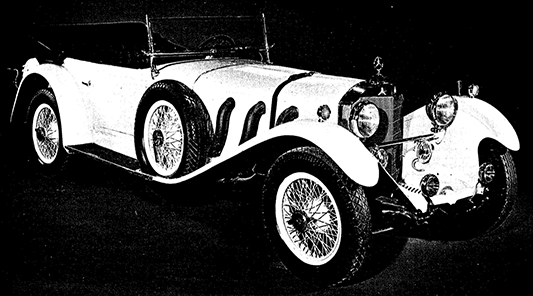
A city is known by the cars on its roads – if we care to tweak the popular saying to some extent. And it is true for Calcutta. Since the early days when motor cars were introduced in India, the city of Calcutta often occupied a pride of place as the largest car market in the country. Cars were shipped in and through its port made it to customers in eastern, northern and central parts of a country that stretched (under colonial rule) from the Khyber Pass to the borders of Burma. Business tycoons, noted foreign agencies and companies, landowning families and successful professionals like lawyers and doctors were major buyers of car for transport and motorsport.
The Calcutta market was unique because it was possibly the only one in which maharajas, nizams and rajas rubbed shoulders with businessmen and professionals in automobile showrooms that were located between central Calcutta and Esplanade and even as far south as Circular Road (at present AJC Bose Road). In all other cities buyers were mostly landowners. In Bombay it was mostly restricted to businessmen.

This Mercedes-Benz participated in the vintage car rally held in Kolkata but was later shipped overseas
Rajas & Zemindars
Many major landowners from all over India possessed large properties in the city for political and financial reasons (several were investors in businesses based in the city). They maintained their fleet at these properties. We must remember that colonial India had 125 princely states and around 450 smaller states at that time, the smallest of which was around 200 square miles in area! In addition, there were hundreds of zemindars. All of them drew substantial income from agriculture and trade.
Even if we leave out non-local princes like the Nizam, one must mention the local big players like the landowners of Nadia and Santosh (now in Bangladesh). Their garages had dozens of cars and they were particularly partial to English brands including Rolls-Royce, Daimler, Austin, Morris and Standard.

This Mercedes-Benz participated in the vintage car rally held in Kolkata but was later shipped overseas
Special mention must be made of the ruling family of Cooch Behar which pioneered motoring in India particularly among the landowning class in Colonial India. Family patriarch Nripendra Narayan (died 1911) hosted foreign auto experts at his estate at Woodlands in Alipore and took them around the country to meet others. His descendants like Jitendra Narayan started the trend of appointing an Englishmen as head of the garage.
Equally special was Rameshwar Singh and Kameshwar Singh of Darbhanga who owned around 100 cars in Calcutta (Darbhanga virtually had no roads). Their collection ranged from Bentley racers and Rolls models to American Packard and Cadillac cars which were maintained at their Chowringhee palace. The family became very famous after it bought the Daimler 1936 Double-Six (12 cylinder) which belonged to King Edward VIII of England. The car was sent to India as Edward was to visit the country; however, in the meantime he renounced the throne. The Maharajah of Darbhanga then bought it from the government.

This Rolls-Royce Silver Ghost belonging to an English gentleman was sold to an Indian. There was a vibrant trade in second hand cars from 1907-08 in the city
Merchant princes & professionals
Cars, often along with drivers were provided to the thousands of managers working in the city or in factories, mines and tea gardens owned by Englishmen. It was these companies that took the first cars to the countryside.
Apart from them, there were Indian merchant princes who owned coal, shipping and mica businesses and also dabbled in cement and jute ventures. The companies possessed large fleets including the rarest Rolls, Bentley and Mercedes, Lancia and Maserati racers. Shaw Wallace had racing Mercedes while Martin Burn had a fleet of Bentley, Daimler and Rolls-Royce cars.
In fact, some 15-odd companies had their own petrol pumps on their premises for their fleets which otherwise created a traffic jam at the public pumps. Tata Ventures flaunted Mercedes and other European cars rather than English cars, though members of the Tata family reportedly favoured Packard models.
The senior most of the Birla families preferred Packard, Cadillac and Hudson cruisers but did maintain a couple of R-R cars too. The Jatia family which bought French Motor cars had their R-R, as did businessmen like the Bubnas and the Howrah-based Kanoria family.
Top notch lawyers and doctors were collectors as well. It was not unusual for such families to have 5-6 large cars ranging from the very proper Daimler and Wolseley limousines to an odd Mercedes. Also popular were the powerful General Motors models, the Ford V8, Chryslers as well as similar cars of American makes which typically offered more power, accessories and comfort available at the same price of English cars.
It would be interesting to note that the actor, Pahari Sanyal owned a very rare rear-engine Mercedes while screen star Chabbi Biswas perished in a car crash. However, they were not collectors.
The diverse nature of the buying class in Calcutta reflected the uniqueness of the city and its cosmopolitan culture. From holding the first motorsport event, launching the first private motor garage in the country to pioneering city bus service, our city has much to be proud of. However, central government policies including the abolition of the privy purse, nationalisation of different sectors, imposition of central tax laws led foreign companies to be driven out and freight equalisation to crush local manufacturing which resulted in collapse of the market and led to a crisis that lasted from the 1970s to the 1990s.